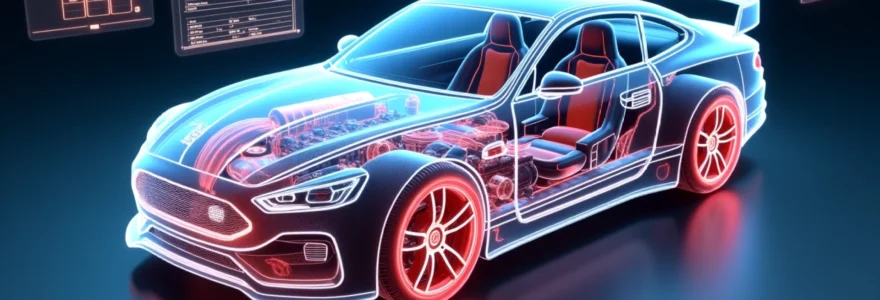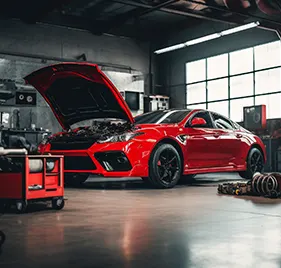Is your vehicle feeling sluggish or underperforming? Over time, even well-maintained cars can experience a decline in performance. However, with the right knowledge and techniques, you can breathe new life into your ride. This comprehensive guide explores proven methods to diagnose issues, optimize engine efficiency, enhance handling, and restore your car's overall performance. Whether you're a seasoned gearhead or a curious car owner, these tips will help you unlock your vehicle's full potential and enjoy a smoother, more responsive driving experience.
Diagnosing performance issues in vehicle systems
Before diving into specific restoration techniques, it's crucial to accurately identify the root causes of your car's performance issues. Start by paying close attention to how your vehicle behaves during acceleration, braking, and cornering. Unusual noises, vibrations, or hesitations can provide valuable clues about underlying problems.
One of the most effective diagnostic tools at your disposal is the On-Board Diagnostics (OBD-II) system. This standardized system allows you to retrieve error codes and real-time data from your car's computer. Investing in a quality OBD-II scanner can help you pinpoint specific issues and make informed decisions about necessary repairs or upgrades.
Additionally, consider factors such as fuel efficiency, exhaust emissions, and overall drivability. A sudden drop in miles per gallon or the appearance of a check engine light can indicate problems with fuel delivery, ignition, or emissions control systems. By systematically evaluating these aspects, you can create a targeted plan for restoring your car's performance.
Engine optimization techniques for improved efficiency
The heart of your car's performance lies in its engine. Optimizing your engine can lead to significant improvements in power, efficiency, and overall drivability. Let's explore some key techniques to enhance your engine's performance.
Upgrading air intake systems: K&N vs. AEM filters
One of the easiest and most effective ways to boost engine performance is by upgrading your air intake system. A high-flow air filter allows your engine to breathe more easily, potentially increasing horsepower and improving fuel efficiency. Two popular options in this category are K&N and AEM filters.
K&N filters are known for their washable and reusable design, offering long-term cost savings. They typically provide a slight increase in horsepower and can improve throttle response. AEM filters, on the other hand, often focus on maximum airflow and filtration efficiency. While both brands offer quality products, your choice may depend on factors such as your specific vehicle model and driving conditions.
Tuning engine control units (ECU) with OBD-II scanners
Modern vehicles rely heavily on their Engine Control Units (ECUs) to manage various aspects of engine performance. By using an OBD-II scanner, you can access and modify certain parameters within your car's ECU. This process, known as ECU tuning or chip tuning, can optimize fuel injection timing, ignition timing, and other critical factors.
When tuning your ECU, it's essential to work within safe limits to avoid damaging your engine. Many OBD-II scanners come with pre-configured maps for popular vehicle models, making the process more accessible to enthusiasts. However, for more advanced tuning, consider consulting a professional to ensure optimal results without compromising reliability.
Replacing worn spark plugs: iridium vs. platinum options
Spark plugs play a crucial role in your engine's combustion process. Over time, they can wear out, leading to misfires, reduced fuel efficiency, and decreased performance. When replacing spark plugs, you'll often encounter a choice between iridium and platinum options.
Iridium spark plugs typically offer superior longevity and performance compared to their platinum counterparts. They can maintain a consistent spark for up to 100,000 miles in some cases. Platinum spark plugs, while still a significant upgrade from standard copper plugs, may need replacement sooner but often come at a lower price point.
Choosing the right spark plug material can significantly impact your engine's performance and maintenance schedule. Consider your driving habits and vehicle specifications when making this decision.
Cleaning fuel injectors using ultrasonic technology
Fuel injectors can accumulate deposits over time, leading to uneven fuel distribution and reduced engine efficiency. Ultrasonic cleaning technology offers a highly effective method for removing these deposits without disassembling the engine.
This process uses high-frequency sound waves to create microscopic bubbles that implode, effectively dislodging contaminants from the injector nozzles. Many professional auto shops offer ultrasonic fuel injector cleaning services, which can restore fuel flow and improve overall engine performance.
Suspension and handling enhancements
While engine performance is crucial, don't overlook the importance of your car's suspension system. A well-tuned suspension can dramatically improve handling, cornering ability, and overall driving experience. Let's explore some key upgrades to enhance your vehicle's suspension and handling characteristics.
Shock absorber replacement: bilstein vs. KYB comparisons
Shock absorbers play a vital role in controlling your car's body movement and maintaining tire contact with the road. Two popular brands in the aftermarket shock absorber market are Bilstein and KYB. Both offer high-quality products, but they cater to slightly different needs.
Bilstein shocks are often praised for their monotube design and gas-pressurized technology, which can provide excellent handling and a firm ride. They're particularly popular among performance enthusiasts. KYB shocks, on the other hand, offer a range of options from OEM-style replacements to performance-oriented models. They're known for providing a good balance between comfort and handling improvements.
Upgrading Anti-Roll bars for improved cornering
Anti-roll bars, also known as sway bars, help reduce body roll during cornering. Upgrading to a stiffer anti-roll bar can significantly improve your car's handling characteristics, especially during aggressive driving or on twisty roads.
When selecting an upgraded anti-roll bar, consider the bar diameter and stiffness rating. A larger diameter generally results in less body roll, but it's essential to balance this with overall ride comfort. Many performance-oriented anti-roll bars offer adjustable settings, allowing you to fine-tune the handling characteristics to your preferences.
Polyurethane bushing installation techniques
Bushings are small components that play a significant role in your car's suspension system. They help isolate vibrations and allow controlled movement between various suspension parts. Over time, factory rubber bushings can degrade, leading to sloppy handling and increased noise.
Upgrading to polyurethane bushings can provide several benefits:
- Improved responsiveness and handling precision
- Greater durability and resistance to degradation
- Reduced wheel alignment changes under load
- Enhanced overall suspension performance
When installing polyurethane bushings, proper lubrication is crucial to prevent squeaking and ensure smooth operation. Use a high-quality, polyurethane-specific lubricant during installation, and be prepared for a slightly firmer ride compared to stock rubber bushings.
Transmission performance restoration methods
Your car's transmission is a complex system that plays a crucial role in overall performance. Whether you have a manual or automatic transmission, proper maintenance and occasional upgrades can significantly improve shift quality, responsiveness, and power delivery.
For manual transmissions, consider upgrading to a high-performance clutch kit. These kits often include stronger pressure plates and more durable clutch discs, allowing for better power transfer and increased longevity under high-stress conditions. Additionally, upgrading to a short-throw shifter can provide quicker, more precise gear changes, enhancing the overall driving experience.
Automatic transmission performance can be improved through several methods:
- Regularly changing transmission fluid and filter
- Installing a high-performance transmission cooler
- Upgrading to a performance valve body for quicker, firmer shifts
- Reprogramming the transmission control module for optimized shift points
Regardless of transmission type, addressing any existing issues promptly can prevent more severe damage and maintain optimal performance. Pay attention to unusual noises, delayed engagement, or slipping gears, as these can indicate underlying problems that require immediate attention.
Brake system upgrades for enhanced stopping power
A high-performance car isn't just about going fast; it's also about stopping effectively. Upgrading your brake system can significantly improve your vehicle's safety and overall performance, especially if you enjoy spirited driving or participate in track events.
Ceramic vs. metallic brake pad selection
Choosing the right brake pads is crucial for optimal stopping performance. Ceramic and metallic brake pads each have their advantages and are suited for different driving styles and conditions.
Ceramic brake pads offer:
- Quieter operation with less brake dust
- Excellent performance in daily driving conditions
- Longer lifespan compared to organic pads
- Stable performance across a wide temperature range
Metallic brake pads, on the other hand, provide:
- Superior heat dissipation for high-performance applications
- Excellent bite and initial stopping power
- Better performance in extreme temperature conditions
- Lower cost compared to ceramic pads
Installing stainless steel braided brake lines
Upgrading to stainless steel braided brake lines can provide a noticeable improvement in brake pedal feel and responsiveness. Unlike rubber brake lines, which can expand under pressure, stainless steel lines maintain consistent volume, resulting in a firmer pedal and more predictable braking performance.
When installing braided brake lines, ensure proper fitment for your specific vehicle model. It's also crucial to bleed the brake system thoroughly after installation to remove any air bubbles that may have entered during the process.
Upgrading to Cross-Drilled and slotted rotors
Cross-drilled and slotted rotors can enhance brake performance, especially under high-stress conditions. The cross-drilled holes help dissipate heat and gases generated during braking, while the slots help clean the brake pad surface and improve initial bite.
When selecting upgraded rotors, consider factors such as your driving style, climate, and typical usage. For daily driving with occasional spirited use, a combination of cross-drilled and slotted rotors often provides a good balance of performance and longevity.
Brake fluid flushing with DOT 4 vs. DOT 5.1
Regular brake fluid flushes are essential for maintaining optimal braking performance. When choosing a brake fluid, you'll often encounter DOT 4 and DOT 5.1 options. Both are glycol-based fluids, but they have different performance characteristics.
DOT 4 brake fluid is suitable for most daily driving applications and is compatible with a wide range of vehicles. DOT 5.1, on the other hand, offers a higher boiling point, making it ideal for high-performance or racing applications where brake temperatures can reach extreme levels.
Regardless of which fluid you choose, always ensure it meets or exceeds your vehicle manufacturer's specifications. Mixing incompatible brake fluids can lead to system failure and compromised safety.
Advanced diagnostics using OBD-II and dyno testing
To truly optimize your car's performance, it's essential to leverage advanced diagnostic tools and techniques. OBD-II scanning and dynamometer (dyno) testing can provide valuable insights into your vehicle's current performance and help identify areas for improvement.
OBD-II scanners have evolved beyond simple code readers. Modern scanners can provide real-time data on various engine parameters, including:
- Air/fuel ratios
- Ignition timing
- Throttle position
- Oxygen sensor readings
- Mass airflow measurements
By analyzing this data, you can identify potential issues before they become serious problems and fine-tune your engine's performance. Dyno testing takes diagnostics a step further by measuring your car's actual power output at the wheels. This process can help you:
- Establish a baseline for your car's current performance
- Quantify the impact of various upgrades or modifications
- Identify power losses in the drivetrain
- Optimize engine tuning for maximum efficiency and power
When combined with OBD-II diagnostics, dyno testing provides a comprehensive picture of your vehicle's performance characteristics. This data-driven approach allows you to make informed decisions about future upgrades and ensure that your car is operating at its peak potential.

